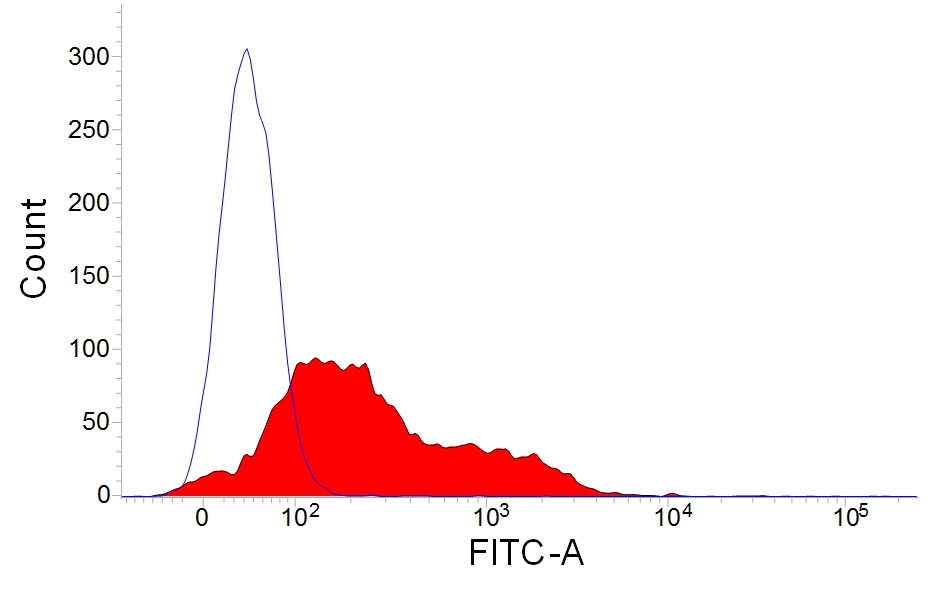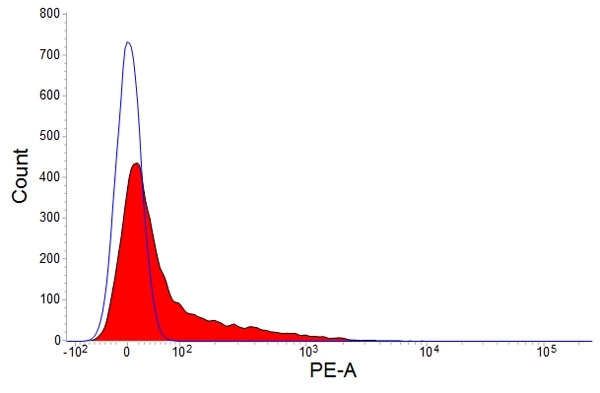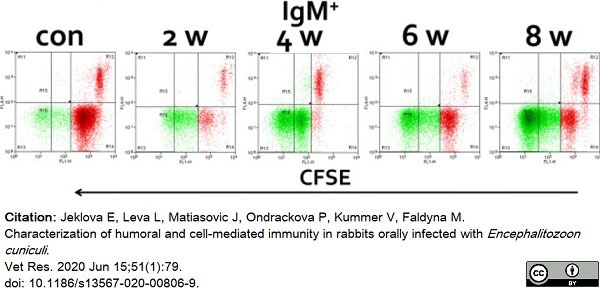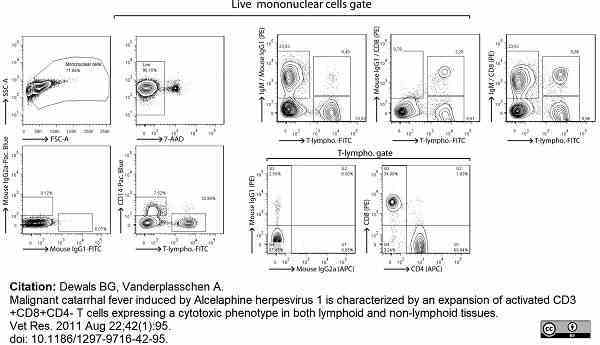IgM antibody | NRBM




Mouse anti Rabbit IgM (B Cell Marker):RPE
- Product Type
- Monoclonal Antibody
- Clone
- NRBM
- Isotype
- IgG1
- Specificity
- IgM
- Region
- (B-CELL MARKER)
| Mouse anti Rabbit IgM (B Cell Marker) antibody, clone NRBM recognizes rabbit IgM. Mammalian IgM is produced and secreted by plasma cells located in bone marrow, lymph nodes and spleen. IgM is present in both a secreted polymeric form and as cell surface monomeric form on B cells. Mouse anti Rabbit IgM antibody, clone NRBM labels IgM+ve B cells (Dewals et al. 2011, Waclavicek et al. 2009) and as such can be considered a reliable marker of lagomorph B cells for flow cytometry. |
- Target Species
- Rabbit
- Product Form
- Purified IgG conjugated to R. Phycoerythrin (RPE) - lyophilized
- Reconstitution
- Reconstitute with 1.0 ml distilled water
- Preparation
- Purified IgG prepared by affinity chromatography on Protein A from tissue culture supernatant
- Buffer Solution
- Phosphate buffered saline
- Preservative Stabilisers
- 0.09% Sodium Azide (NaN3)
1% Bovine Serum Albumin
5% Sucrose - Fusion Partners
- Spleen cells from immunized mice were fused with cells of the Mouse P3X63Ag8.653 myeloma cell line.
- Max Ex/Em
-
Fluorophore Excitation Max (nm) Emission Max (nm) RPE 488nm laser 496 578 - Regulatory
- For research purposes only
- Guarantee
- 12 months from date of despatch
After reconstitution store at +4oC.
DO NOT FREEZE. This product should be stored undiluted. This product is photosensitive and should be protected from light.
| Application Name | Verified | Min Dilution | Max Dilution |
|---|---|---|---|
| Flow Cytometry | Neat |
- Flow Cytometry
- Use 10ul of the suggested working dilution to label 1x106 cells in 100ul.
How to Use the Spectraviewer
Watch the Tool Tutorial Video ▸- Start by selecting the application you are interested in, with the option to select an instrument from the drop down menu or create a customized instrument
- Select the fluorophores or fluorescent proteins you want to include in your panel to check compatibility
- Select the lasers and filters you wish to include
- Select combined or multi-laser view to visualize the spectra
| Description | Product Code | Applications | Pack Size | List Price | Your Price | Quantity | |
|---|---|---|---|---|---|---|---|
| Mouse anti Rabbit T Lymphocytes:FITC | MCA800F | F | 100 Tests |
|
Log in | ||
| List Price | Your Price | ||||||
|
|
Log in | ||||||
| Description | Mouse anti Rabbit T Lymphocytes:FITC | ||||||
References for IgM antibody
-
Idogawa, H. et al. (1997) Progression of articular destruction and the production of tumour necrosis factor-alpha in antigen-induced arthritis in rabbits.
Scand J Immunol. 46 (6): 572-80. -
Dewals, B. et al. (2008) Malignant catarrhal fever induced by alcelaphine herpesvirus 1 is associated with proliferation of CD8+ T cells supporting a latent infection.
PLoS One 3: e1627. -
Gillet, L. et al. (2009) Anchoring tick salivary anti-complement proteins IRAC I and IRAC II to membrane increases their immunogenicity.
Vet Res. 40: 51. -
Stich, N. et al. (2010) Staphylococcal superantigen (TSST-1) mutant analysis reveals that t cell activation is required for biological effects in the rabbit including the cytokine storm.
Toxins (Basel). 2 (9): 2272-88. -
Waclavicek, M. et al. (2009) Analysis of the early response to TSST-1 reveals Vbeta-unrestricted extravasation, compartmentalization of the response, and unresponsiveness but not anergy to TSST-1.
J Leukoc Biol. 85 (1): 44-54. -
Anderson, I.E. et al. (2008) Production and utilization of interleukin-15 in malignant catarrhal fever.
J Comp Pathol. 138: 131-44. -
Dewals, B.G. and Vanderplasschen, A. (2011) Malignant catarrhal fever induced by Alcelaphine herpesvirus 1 is characterized by an expansion of activated CD3+CD8+CD4- T cells expressing a cytotoxic phenotype in both lymphoid and non-lymphoid tissues.
Vet Res. 42: 95. -
Dewals, B. et al. (2011) Ex vivo bioluminescence detection of alcelaphine herpesvirus 1 infection during malignant catarrhal fever.
J Virol. 85: 6941-54.
View The Latest Product References
-
Milanovic, V. et al. (2017) Histological and immunological changes in uterus during the different reproductive stages at Californian rabbit (Oryctolagus cuniculus).
Kafkas Univ Vet Fak Derg, 23, 137-44. -
Ondruska, L. et al. (2016) Decrease in C-reactive protein levels in rabbits after vaccination with a live attenuated myxoma virus vaccine.
Veterinární Medicína. 61 (No. 10): 571-6. -
Myster, F. et al. (2015) Viral semaphorin inhibits dendritic cell phagocytosis and migration but is not essential for gammaherpesvirus-induced lymphoproliferation in malignant catarrhal fever.
J Virol. 89 (7): 3630-47. -
Sorel, O. et al. (2017) Macavirus latency-associated protein evades immune detection through regulation of protein synthesis in cis depending upon its glycin/glutamate-rich domain.
PLoS Pathog. 13 (10): e1006691. -
Jeklova, E. et al. (2020) Characterization of humoral and cell-mediated immunity in rabbits orally infected with Encephalitozoon cuniculi..
Vet Res. 51 (1): 79. -
Niedżwiedzka-Rystwej, P. et al. (2020) B and T lymphocytes in rabbits change according to the sex and throughout the year.
Pol J Vet Sci. 23 (1): 37-42. -
Muñoz-Silvestre, A. et al. (2020) Pathogenesis of Intradermal Staphylococcal Infections: Rabbit Experimental Approach to Natural Staphylococcus aureus Skin Infections.
Am J Pathol. 190 (6): 1188-210. -
Niedżwiedzka-Rystwej, P. et al. (2022) Reactivity of selected markers of innate and adaptive immunity in rabbits experimentally infected with antigenic variants of RHD (Lagovirus europaeus/GI.1a).
Vet Res Commun. 46 (1): 233-42.
- UniProt
- P04221
- P03988
- GO Terms
- GO:0003823 antigen binding
- GO:0005886 plasma membrane
- GO:0016021 integral to membrane
MCA812PE
If you cannot find the batch/lot you are looking for please contact our technical support team for assistance.
Please Note: All Products are "FOR RESEARCH PURPOSES ONLY"
View all Anti-Rabbit ProductsAlways be the first to know.
When we launch new products and resources to help you achieve more in the lab.
Yes, sign me up


